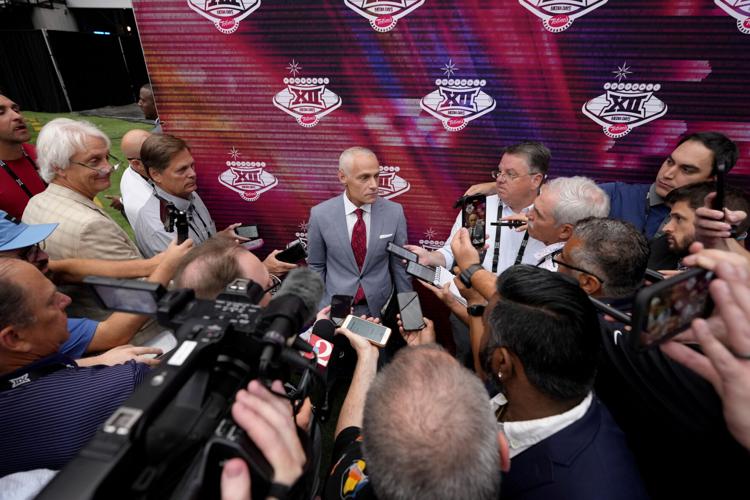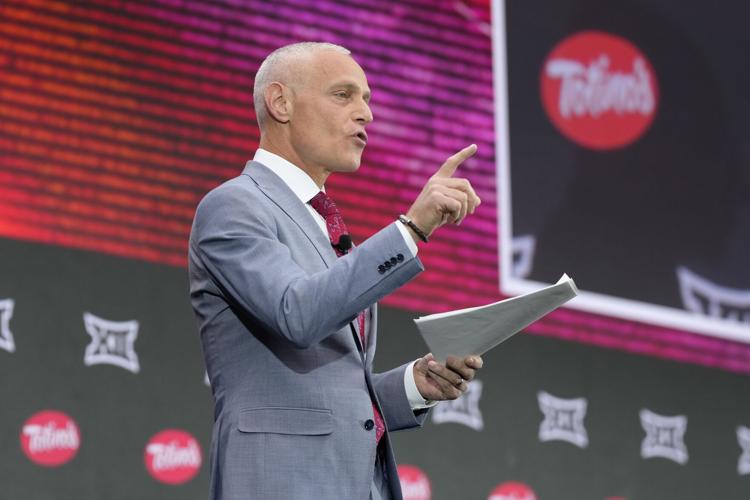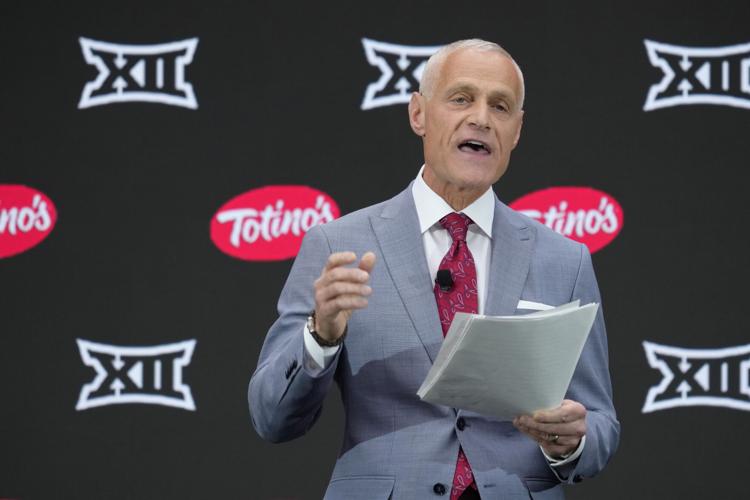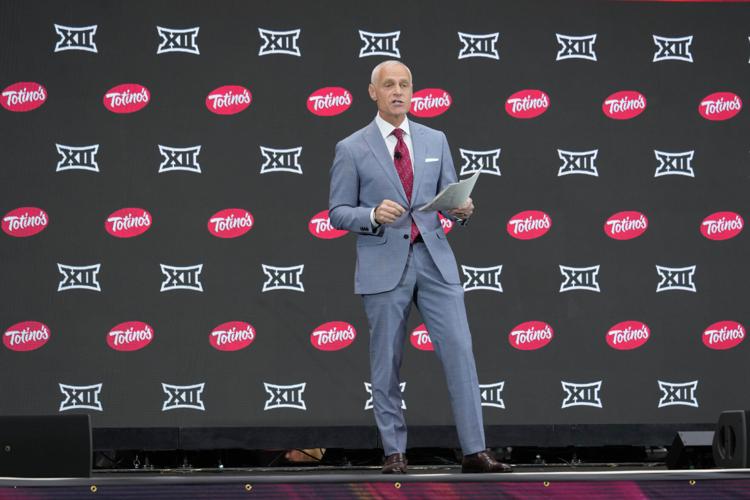LAS VEGAS — The Big 12 doesn’t officially begin the onboarding process for its newcomers, like the Arizona Wildcats, until Aug. 2, but the 16-team conference jumpstarted its new era Tuesday with the opening session of the Totino’s Big 12 Media Days.
Big 12 commissioner Brett Yormark, a longtime sports and entertainment mogul, kicked off the two-day event with an introductory monologue of sorts, declaring that “there has never been a better time than right now to be a part of the Big 12.”
Similarly to the late Steve Jobs at an Apple event, Yormark paced the main stage at Allegiant Stadium, the 2024 site for Big 12 Media Days, after it was previously held at AT&T Stadium in Arlington, Texas.
With the Big 12 adding “four corners” schools Arizona, Arizona State, Colorado and Utah from the Pac-12, Yormark said he’s “incredibly excited about what they bring to our league.”
Yormark, who Oklahoma State head coach Mike Gundy called “innovative, smart and not afraid to take a chance,” did what he does best: advertise, promote and update.

Big 12 Commissioner Brett Yormark delivers his opening remarks at the start of the 2014 Big 12 Media Days Tuesday at Allegiant Stadium in Las Vegas.
Yormark noted nine Big 12 teams participating in bowl games last season and six national championships across all sports. Off the field, “sponsorship business grew by 79%,” the Big 12 garnered the second most-followed social media accounts among collegiate athletic conferences and “our ticket business grew 23%,” according to Yormark. Yormark also referenced next year’s first Big 12 Pro Day in Dallas before the NFL Draft “to build our partnership with the NFL, as we as a conference continue to innovate and grow.
“It was certainly a great year both on and off the field for the Big 12,” Yormark added. “But I often say, I’m happy but not satisfied. People keep asking what’s next? ... On the football front, we will be the deepest conference in America. Every week will matter. I’m going to say that one more time: We will be the deepest conference in America and every week will matter.
“We have star power and parity. We boast some of the top players and coaches in the game. November will be incredibly exciting, and we will brand it as a race to the championship. Beyond football, the best conference in basketball got better. Our Olympic sports got stronger, adding four programs with an incredible history of excellence,” he said of the Wildcats, Sun Devils, Utes and Buffaloes.

Big 12 Commissioner Brett Yormark delivers his opening remarks at the start of the 2014 Big 12 Media Days Tuesday at Allegiant Stadium in Las Vegas.
The Big 12’s “top priority is growth and creating value for our member institutions. I often refer to our league as a mature startup. This means our brand can be younger, more progressive and innovative, compared to some of our peers,” Yormark said.
Yormark said the “value creation must be done in a strategic way,” starting with Fox and ESPN, which is a part of the Big 12’s media rights deal that will pay each member $31.7 million annually through 2031.
“We are taking an innovative approach exploring new TV windows and giving fans more access to our programming,” said Yormark, whose address, along with most of the day’s proceedings, were broadcast either via ESPNU or ESPN+. “As we build our brand, we will continue to build our business. We will not stumble into this new era following settlement. In fact, we will be aggressive and very proactive.”
In the ever-changing, football-driven college athletics landscape, the Big 12 “will push at the NCAA level” for commercial marketing on uniforms of on-field officials. After the NCAA recently approved of teams having on-field logos, Big 12 member Texas Tech will have large-format Adidas and Patrick Mahomes logos at midfield. Mahomes, the three-time Super Bowl-winning quarterback of the Kansas City Chiefs, is a TTU alumnus.
“I’ve been very vocal with the NCAA to push for making commercial patches permissible for officials’ uniforms, similar to what the NBA has done,” Yormark said. “I’ve spoken to our football officials, and they are in favor of it, and I’m optimistic that will happen soon.”
The Big 12 is also “exploring all options” for a naming rights deal for the conference,” Yormark added; that statement came a few weeks after insurance carrier Allstate, already a Big 12 partner in other ways, Yormark reminded Tuesday, was floated as a potential candidate to secure those naming rights.
Yormark announced the Big 12’s partnership with Microsoft, which will allow coaches to use tablets on the sidelines and in the coaching booths during games, in addition to a conference-branded channel on TuneIn Radio. The conference is also working on a FAST (free ad-supported television) channel platform.
Whew.
Some would say the Big 12 and the rest of the collegiate athletics “are going through change, but I would rather call it a necessary reset,” Yormark said.

Big 12 Commissioner Brett Yormark answers questions from the media during the first day of the conference’s annual media days event on July 9 in Las Vegas.
“In 10 years, I think we look back at this period as a positive moment in collegiate athletics history,” he added. “I live my life by the value equation. Those that create value deserve to be rewarded.
“As we enter this new chapter, I can assure you Big 12 schools will compete at the highest levels and they will continue to invest. We’ve been preparing for this moment for a long time, and as commissioner, I will continue to create value for our members in order for them to be as competitive as possible,” he added. “This is no time to press pause. We must continue to be bold and aggressive as an industry. The Big 12 will always be ambitious because that’s who we are. I know there’s a lot of pressure on a lot of people right now, but I will leave you with this: pressure is a privilege.”
Yormark continued his news conference by answering questions from media in attendance. The following is a lightly-edited sampling of some of those questions, and Yormark’s responses:
With Texas and Oklahoma now in the SEC, how does the Big 12 improve with Arizona, ASU, Colorado and Utah?
A: “I’ve been saying it for a year now, but the four corners was the ‘A’ scenario for us when we thought about realignment. Big brands, great markets, engaged fan bases, both academic and athletic excellence. As I said earlier, we got deeper and better in football, we got deeper and better in basketball, and we got deeper and better in Olympic sports. So it’s been a win for this conference, and I’m thrilled and excited, on August 2, to officially welcome the four corners.”
As the SEC and Big Ten continue to evolve and flex their muscles and ‘power play,’ how do you envision the Big 12 responding?
A: “I wake up every morning, I think about one thing: the Big 12 being the best version of itself. Everything else doesn’t really matter. And if we take care of business, we’re going to be just fine, and I’m a firm believer in that.
“As I said earlier, we’re more relevant now than we’ve ever been. We’re a national conference. We’ve got 16 great brands. We’re going to be the deepest football conference in America. We’ll be well-represented in the CFP. Everything else is just speculation.

Big 12 Commissioner Brett Yormark opens the 2024 Big 12 football Media Days Tuesday in Las Vegas.
“I’m really, really focused on just making sure the Big 12 is the best version of itself, and not only have we had a great 24 months, but we continue to get better.”
There have been rumors of the College Football Playoff expanding to 14 teams in the future, with first-round byes exclusive to Big Ten and SEC schools. How do you respond to that potential model?
A: “From my perspective, we’re just getting into this new format of 12 schools, and we’ve got to see how that works. And we’re very excited about what that new format looks like. Obviously the Big 12 will be represented by one team at least — possibly more, probably more. And we’ll have to see how it unfolds, but from my perspective anything beyond this year is just speculation. Let’s get this year right. We’re all blessed to have games on campus in that first round. I’m looking forward to it, and we’ll see where it takes us moving forward.”
How will private equity fit into the new model of college football? How does the Big 12 work in private equity without longterm liabilities?
A: “I’m not going to get into too much of a conversation on private equity, but as I said earlier, we’re exploring all options. I do believe that, given where we are, the industry, having a capital resource as a partner, makes a ton of sense. That’s really how you conduct good business. I really believe that.
“And if you see where private equity is kind of making a path into professional sports, at some point in time it’s going to come here into intercollegiate athletics. We’re exploring what that might look like. And a structure and a model of what that looks like is going to be critically important so that we’re not compromising the longterm future of the conference.”
Is there a number that’s too big for conference membership?
A: “I often get asked about expansion and what’s next. I’m really focused on the current composition of our conference. We’ve expanded a lot. My wife told me the other day, ‘When you took the job, you had 10 schools; you have 16 now. That’s in a very short period of time, in less than 24 months. So we’ve got to make sure as a collective group, we’re reaching our potential.
“So I haven’t really thought about what’s the right number. I don’t know if it’s really about a number. I think it’s about the right fit. It’s about the value of potential school might or might not bring to the conference. But right now we’re focused on 16. We’re focused on getting this right, and I’m really excited about our future as a 16-team league.”







